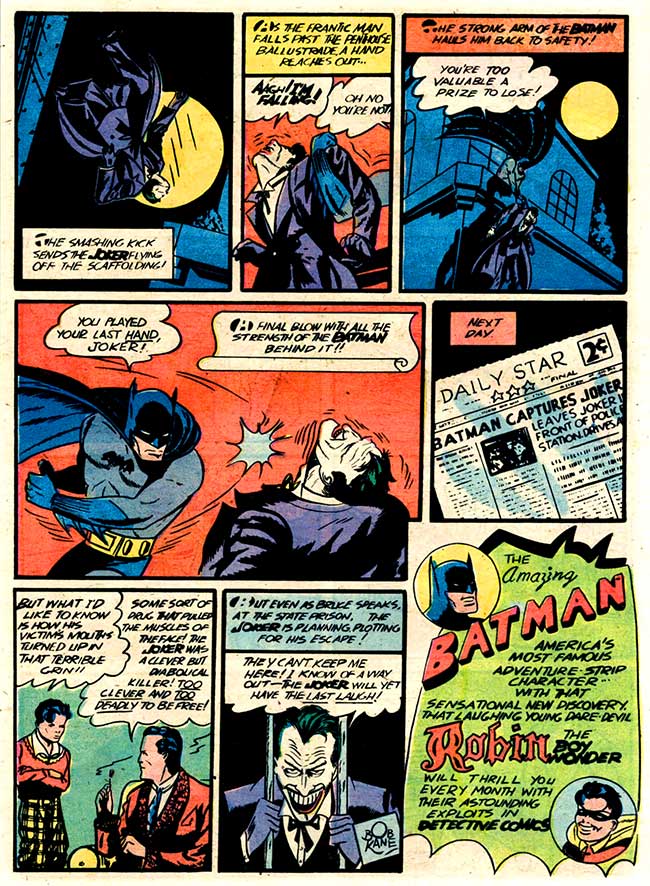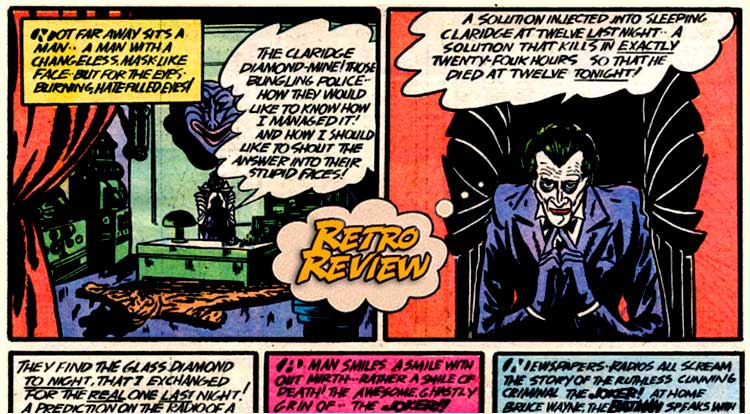Sure, it’s the first origins of the Bat-Man, but the real show is the introduction of that *other* guy… Your Major Spoilers (Retro) Review of Batman #1 awaits!
 BATMAN #1
BATMAN #1
Writer: Bill Finger
Penciler: Bob Kane/Jerry Robinson
Inker: Bob Kane,/Sheldon Moldoff/Jerry Robinson
Colorist: Petra Goldberg
Letterer: Sheldon Moldoff/Jerry Robinson
Editor: Roy Thomas
Publisher: Marvel Comics
Cover Price: 20 Cents
Current Near-Mint Pricing: $20.00
Previously in Batman: Initially created to capitalize on the immediate popularity of Superman, The Bat-Man was a success with readers almost immediately. After only a few appearances in the pages of Detective Comics, he was awarded his own quarterly title featuring only Batman stories in a time where most comics were anthologies. After only five issues, the book went monthly, making it clear that Bruce Wayne’s alter ego was a big deal, and these earliest appearances are remarkably fully-formed. Most Golden Age superheroes still extant have been through HUGE changes, but this issue presents a The Bat-Man remarkably like one you might read about today, including his iconic origins in Crime Alley, and the tragic deaths of Thomas and Martha Wayne. All of these details are credited to Bill Finger, who ghost-wrote the book even though only Bob Kane was credited (thanks reputedly to the terms of Kane’s contract) and even created the most iconic villain Gotham City. Our story starts with a message breaking into the nightly radio broadcast, announced that millionaire Henry Claridge will die precisely at midnight!

Also worth noting is the quality of the art by Kane and Jerry Robinson, who reputedly created The Joker’s visuals, which is remarkably clear and well-constructed, especially by Golden Age standards. There’s still a crudity to the figures, but there are details backgrounds and recognizable “acting” from the characters on the page, something that many comic books circa 1940 couldn’t deliver on. After successfully killing Claridge and stealing his diamond, The Joker once again breaks into the broadcasts to announce his next target: The Ronkers Ruby! Even with a room full of police protection, Ronkers is killed and The Joker (who was IN THE ROOM the whole time, disguised as a suit of armor) escapes scot-free. This brings out The Bat-Man, who acts on underworld rumors to target Joker’s next victim!

The Bat-Man’s costume is even fully-formed here, save for a yellow chest-circle or two, and the Caped Crusader goes head-to-head with the Clown Prince of Crime. Remarkably, The Joker gets the upper hand and KICKS the Bat off the Gotham Bridge to a seeming doom. Later that night, he sends yet another broadcast of doom, this one aimed at Judge Drake, who once sent him to jail (a tantalizing hint of Joker stories that we never heard about that occurred before this one.)

It would be really fun to see Joker disguised as Commissioner Gordon here, but sadly it’s not to be. (Though the character exists, having first appeared in Detective #27, and this looks like his modern incarnation, the Golden Age Jim Gordon has a pencil mustache and doesn’t wear a uniform. Bummer…) Murdering the Judge, The Joker escapes into the night, only to be met with The Bat-Man and Robin, entering into combat with the dynamic duo. Robin takes a hit from the villain, but gets in a few licks of his own, kicking him to what should be certain death!

Joker vows to break out and get the Last Laugh, and amazingly, he does so WITHIN THE PAGES OF THIS FIRST APPEARANCE! After a return bout with Professor Hugo Strange (who first appeared in Detective Comics #36 the previous year) AND the first appearance of the woman who would become Catwoman, Joker busts out to get his revenge on the Bat. Having been imprisoned for two whole days, The Joker uses explosives implanted in a pair of false teeth (!!) to blow his way out of jail and sets off calling his murders once again, like Babe Ruth with his home runs. This time, The Bat-Man is prepared and STILL the evil clown manages to kill three more people before the hero (and a little dramatic irony) catch up with The Joker.

The Joker dies, struck down by his own hand with a blade in the heart…
…or, at least, that’s what Finger intended. The editors, struck by how strong this new character was, insisted that he couldn’t be killed that quickly, and the last panels of the story were rewritten before print to indicate that he was, in fact, still alive. In fact, this second story was intended to appear in Detective Comics #40, but was presented here because the creators and editors felt that they had a hit on their hands with the pale-faced Harlequin of Hate. Batman #1 proves that they were right about The Joker, and about of lot of things in the development of The Bat-Man (whom I will continue to write with a hyphen because it looks cooler and because I can) with above-average art and some truly ingenious story tricks, earning a well-deserved 4 out of 5 stars overall. As someone who reads a lot of Golden Age comic books, I can tell you that this is a truly remarkable comic, not only in terms of historical importance, but in terms of its quality.
Dear Spoilerite,
At Major Spoilers, we strive to create original content that you find interesting and entertaining. Producing, writing, recording, editing, and researching requires significant resources. We pay writers, podcast hosts, and other staff members who work tirelessly to provide you with insights into the comic book, gaming, and pop culture industries. Help us keep MajorSpoilers.com strong. Become a Patron (and our superhero) today.
BATMAN #1
Even this early in his history, much of The Bat-Man's modus operandi is already established, and the addition of The Joker really highlights how good a character he is and how talented these creators are.
-
Writing
-
Art
-
Coloring


